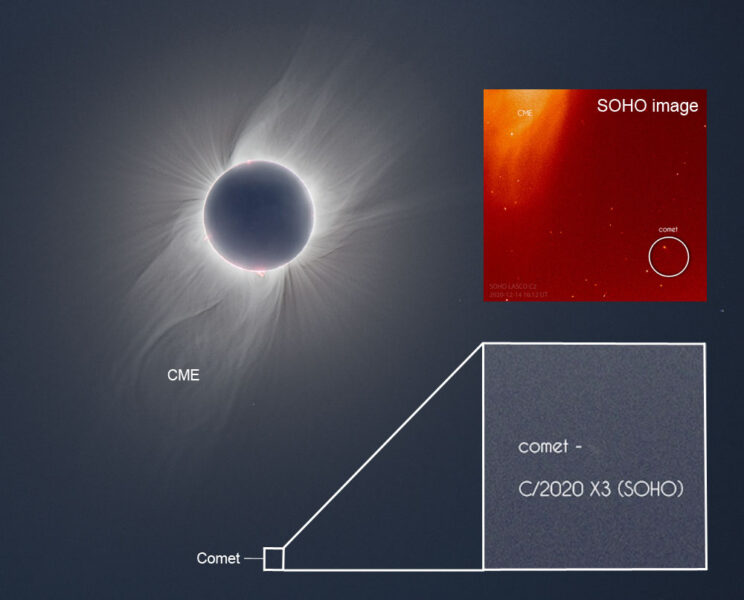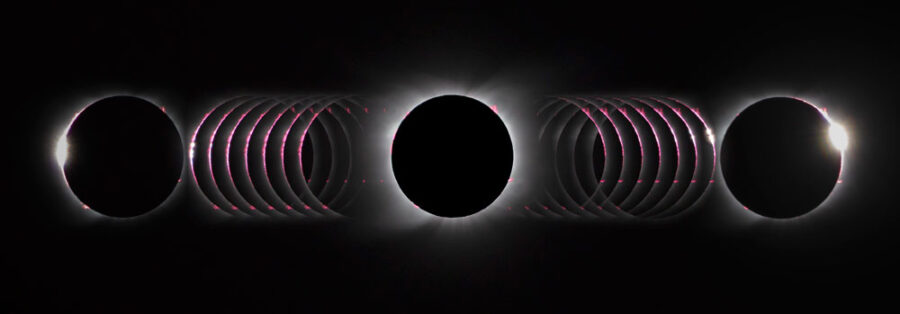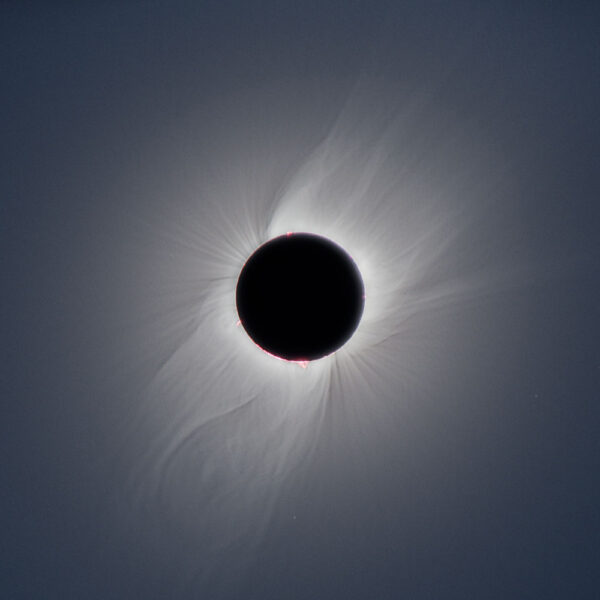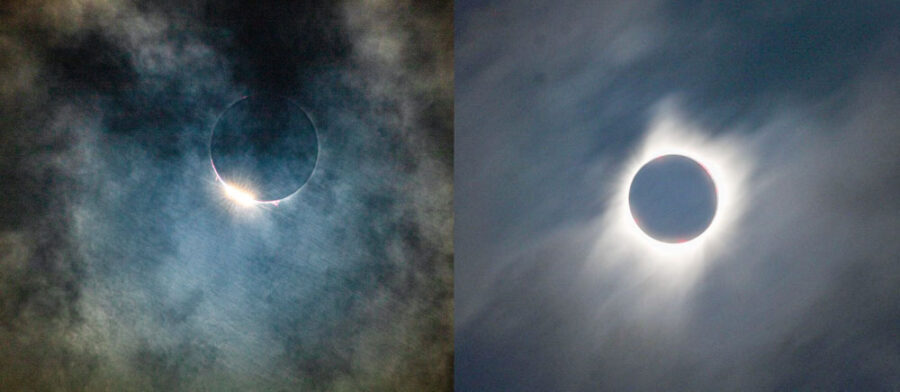The recent total solar eclipse visible from Chile and Argentina had a few surprises in store.
The total solar eclipse of December 14, 2020, crossing northern Patagonia in Chile and Argentina, was a treat for only a few — but the surprises it held are for everyone.

Photo: G. Abramson / Upper inset: SOHO
COVID-19 travel restrictions forced most eclipse aficionados and scientific expeditions that would normally crowd the path of totality to cancel their plans. Cloudy skies greeted those who reached the Chilean portion of the 56-mile-wide path of the lunar umbra.
In Argentina, authorities granted locals permission to travel only a few days before the event, with reasonable restrictions for safety. Thousands gathered in the seaside city of Las Grutas and nearby resorts on the Atlantic Coast. Clouds gathered too, but fortunately cleared just before totality.
Observing from the Argentinian Steppe
As expected, the skies were clear over most of the steppe between the Andes and the Atlantic. I had traveled to Piedra del Águila, a small town in the Limay River valley that had the best weather prospects, and was not disappointed.
I moved a little closer to the central line, to enjoy a few more seconds and to avoid the crowds in Piedra del Águila. I set up my equipment near the Pichi Picún Leufú dam, with the Patagonian winds blowing with gale force. I took what little cover I could next to the scarce vegetation. I had carried a small equatorial mount, a Canon T3i camera and a Tamron 18-270 lens. A Lua script running in-camera, via the Magic Lantern operating system available for Canons, would take all of the exposures automatically; I only had to sit and wait with mounting anticipation as the oh-so-long partial phase progressed.
Only those who have stood in the umbra of the Moon and experienced a total solar eclipse understand the difference between a 95%-covered eclipse and a total is not 5% — it is 100%!
Only during a total solar eclipse does the Moon completely cover the Sun’s bright surface, known as the photosphere, turning day into night in moments. The sky dims to a dark blue reminiscent of twilight. The planets Venus and Mercury suddenly appeared next to the eclipsed Sun. Jupiter and Saturn, already in their Great Conjunction, appeared a little farther away on the other side. And where the Sun had been just seconds before was the Moon’s dark silhouette, surrounded by the ghostly solar corona, the immense atmosphere of the Sun, combed in petals and filaments by its magnetic field.

G. Abramson
This eclipse looked very different from the one in 2019, which also crossed Chile and Argentina 1,000 miles to the north. The corona was more radially symmetrical, and I could see large prominences all around the limb, distinct and vividly red even to the naked eye. Both phenomena are related to the Sun emerging from its minimum of activity in late 2019. The corona appeared a fiery silver-white, instead of its mother-of-pearl appearance in 2019.
Next-day Surprises: CME and Comets
The 2 minutes, 5 seconds of totality ended too soon, as always, but analysis of the photographs I took revealed several surprises the next day.
The corona showed a tear-shape structure that any astronomer, amateur or pro, would immediately recognize as the shock front of a coronal mass ejection. A quick check of Solar and Heliospheric Observatory (SOHO) images confirmed that there had been a medium-size solar flare in active region 2792 just as the eclipse was starting. The accompanying coronal mass ejection had already blown a bubble larger than the Sun itself by the time totality started.
Specialized instruments called coronographs, like the one onboard SOHO, produce artificial solar eclipses that allow astronomers to observe these violent events as they propagate from the corona outward into interplanetary space. But coronagraphs cover an area larger than the solar disk, so it is only during a natural eclipse that we can witness the structures of the corona down to its lowest layers. Observations like this one stress the scientific relevance that total solar eclipses have, even in the time of space telescopes.

G. Abramson
Further examination revealed another surprise: The image had captured a comet! During the eclipse, I had briefly, and without success, scanned the sky for Comet Erasmus (C/2020 S3) between Mercury and Venus. The comet had reached perihelion on the day before. But here there was another one, again confirmed in SOHO’s images. Indeed, Thai amateur astronomer Worachate Boonplod had discovered Comet C/2020 X3 (SOHO) only the day before. The small sungrazer of the Kreutz family was vaporized soon after the eclipse. (Some images actually managed to capture both comets.)
Many of us could also see prominent shadow bands slithering on the landscape shortly before and after totality. A friend described them as “the shadow of the wind.” Less poetically, these swiftly moving shadows are a scintillation phenomenon. They become visible when the tiniest slice of photosphere remains visible, as atmospheric cells of varying density focus the collimated light. The effect is just like starlight scintillation, only it’s much brighter so observers can see it projected on surfaces.

P. Barrios
In 2019 and in 2020 the path of totality crossed Argentina and Chile — next year the path again runs close to home: totality will engulf the Argentine Orcadas base in Antarctica on December 4, 2021. We hope to report from there.
Guillermo Abramson is a physicist at the Statistical and Interdisciplinary Physics group of the Bariloche Atomic Center, in Bariloche, Argentina. He is also an author and popularizer of astronomy and regularly writes a Spanish-language astronomy blog, En el Cielo las Estrellas.
 0
0









Comments
You must be logged in to post a comment.